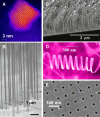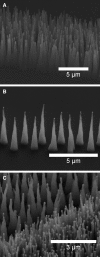Nano-enabled synthetic biology
- PMID: 17625513
- PMCID: PMC1948103
- DOI: 10.1038/msb4100165
Nano-enabled synthetic biology
Abstract
Biological systems display a functional diversity, density and efficiency that make them a paradigm for synthetic systems. In natural systems, the cell is the elemental unit and efforts to emulate cells, their components, and organization have relied primarily on the use of bioorganic materials. Impressive advances have been made towards assembling simple genetic systems within cellular scale containers. These biological system assembly efforts are particularly instructive, as we gain command over the directed synthesis and assembly of synthetic nanoscale structures. Advances in nanoscale fabrication, assembly, and characterization are providing the tools and materials for characterizing and emulating the smallest scale features of biology. Further, they are revealing unique physical properties that emerge at the nanoscale. Realizing these properties in useful ways will require attention to the assembly of these nanoscale components. Attention to systems biology principles can lead to the practical development of nanoscale technologies with possible realization of synthetic systems with cell-like complexity. In turn, useful tools for interpreting biological complexity and for interfacing to biological processes will result.
Figures




References
-
- Aharoni A, Amitai G, Bernath K, Magdassi S, Tawfik DS (2005a) High-throughput screening of enzyme libraries: Thiolactonases evolved by fluorescence-activated sorting of single cells in emulsion compartments. Chem Biol 12: 1281–1289 - PubMed
-
- Aharoni A, Griffiths AD, Tawfik DS (2005b) High-throughput screens and selections of enzyme-encoding genes. Curr Opin Chem Biol 9: 210–216 - PubMed
-
- Ajayan PM, Ebbesen TW (1997) Nanometre-size tubes of carbon. Rep Prog Phys 60: 1025–1062
-
- Anderson PW (1972) More is different—broken symmetry and nature of hierarchical structure of science. Science 177: 393–396 - PubMed
Publication types
MeSH terms
Grants and funding
LinkOut - more resources
Full Text Sources

